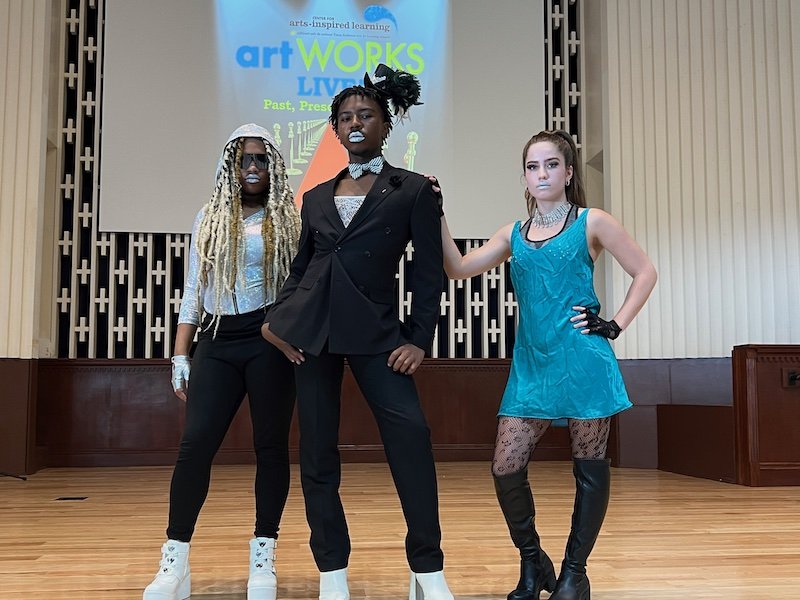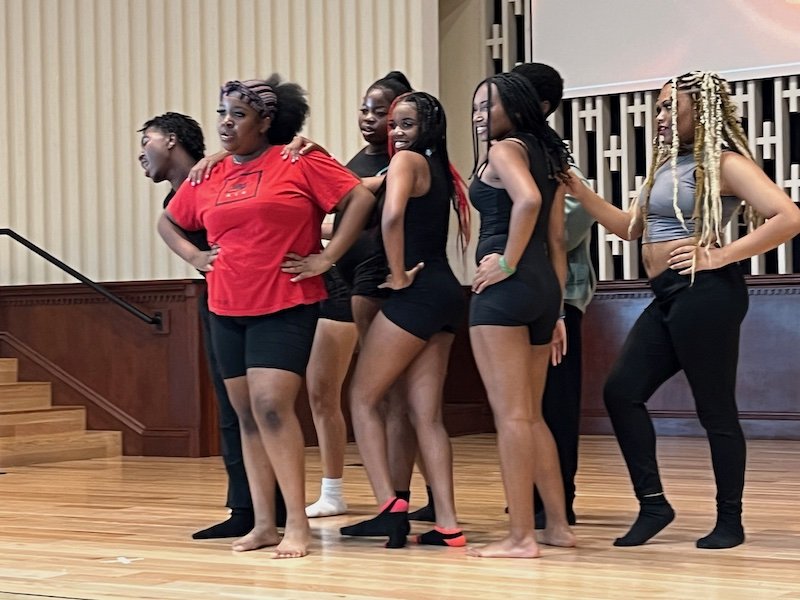Art as a Catalyst for Learning
“We are helping students imagine what their life would look like in a career in the arts.”
-Sheffia Randall-Nickerson, CEO & President, Center for Arts- Inspired Learning
On a steamy summer afternoon in a spacious church in Cleveland Heights, a handful of teenage artists take a break from a hectic, down-to-the-wire dress rehearsal to discuss ArtWorks and how it has impacted their lives:
“ArtWorks feels like home. Everyone here sees us for who we are. I can be myself and trust everyone.”
“ArtWorks shows you that being an artist is a real job and that you can pursue what you love to do, and it is valid.”
“I value the relationships I’ve made at ArtWorks. I’ve met some amazing people.”
“I keep coming back because, number one, ArtWorks is like family.”
“ArtWorks is a space where you can express yourself completely. Usually, when people give young people the space to express themselves, they do it within a box. At ArtWorks, we are given complete autonomy.”
These teens were among 40 rising 10th- 12th- graders from northeast Ohio who participated in the intensive summer arts program known as ArtWorks, a program offered by the Center for Arts-Inspired Learning (CAL) in Cleveland. The experience is designed to give them an idea of what it would be like to be a professional artist. At the time, these students were preparing for what they described as a “Met Gala” fashion show designed to showcase what they had learned during the prior six weeks.
“ArtWorks is near and dear to my heart because as a teenager, I was participating in programs like this and dreaming, wishing, and wondering what my life would look like in the arts,” remarks Sheffia Randall-Nickerson, a trained musical theater artist and CAL’s CEO & President. ArtWorks, she says, helps students imagine that life.
ArtWorks is described as “job readiness infused with the arts.” Student “apprentices” hone artistic skills while building valuable competencies to succeed in any traditional or arts-based career. They participate in co-ops centered around a specific arts discipline and learn from professional teaching artists and mentors. They work in teams, meet deadlines, create portfolios, and make presentations. In the process, they build self-confidence and learn to communicate, collaborate, network, and problem-solve.
During the summer, the program runs from 9:30 to 3:30, five days a week. Apprentices are expected to arrive on time, give a full day’s effort, and contribute to a culminating performance that showcases what they learned during the six-week stint. The showpiece allows them to present themselves as professional artists.
While ArtWorks started 18 years ago as a summer program only, in 2013 it expanded to include after-school sessions in the spring and fall. Each session focuses on specific art forms. Over the years, these have included poetry, songwriting, theater, film, podcasting, recording arts, and comic book illustration. Fashion design, photography, stage makeup design, and modeling & dance were on the agenda this past summer. CAL relies on a network of professional artists with skills in these disciplines to work intensely with apprentices throughout the sessions.
“We swap out art forms and disciplines each session depending on feedback from the apprentices,” explains Emma Parker, CAL’s Senior Director of Arts Education. “We look at each session not only through the traditional lens of artistry, but we include experiences a typical individual might not call an artform but require artistic skills and creative processes to produce, such as makeup or costume design.
“We also swap out the teaching artists to expose the apprentices to a broad network of people who can help them beyond our program as mentors, educators, and artists.”
While the apprentices learn and create, Ms. Parker explains, they also earn a stipend. “I wish someone would have paid me to take dance class when I was young,” she says, stressing that the paycheck is a vital aspect of the program. Teens are taught the expectations they will encounter in adulthood, and their total earned stipend reflects their ability to meet typical job requirements. Students also attend workshops designed by various community partners where they learn about the college application process, financial literacy, and other opportunities available to them beyond high school.
To participate in any ArtWorks session, prospective candidates complete an application and sit for an interview, as they would for any potential job. A background in art is not required, but an enthusiasm for the opportunity is a must.
“We are really looking for young people who might be on the verge of their creativity,” explains Ms. Randall-Nickerson, “students who have an artistic sensibility.” They may have a creative yearning within them, she adds, and want to meet others who feel similar.
ArtWorks provides a safe place for the apprentices to build the family-like community the students highlight as the program’s strength. The curriculum is designed to build five social-emotional competencies as the students work through the apprenticeship. These are self-awareness, social awareness, relationship building, self-management, and responsible decision-making.
Without exception, the students agree they would recommend ArtWorks to siblings or peers. A senior from Lakewood High School, who has participated in four different sessions, says, “I take ArtWorks because I am very passionate about art. It’s like a second school where I can take my favorite classes and get paid. It’s just truly awesome.
“I would encourage others to take it, but not to do so just for the money; that’s not the point,” she continues. “Take it because of the sense of community you get, the knowledge you gain, and the information you learn. The little bit of cash gives you an idea of what it’s like to be a paid artist.”
“The sweetest thing about ArtWorks is the way the program is so beautifully built,” adds a Cleveland School for the Arts senior. “When you experience something this good and heartwarming, you want everyone to share it.”
Ms. Randall Nickerson explains that CAL is accustomed to adapting arts program curricula to address academic learning standards as well, and ArtWorks is no exception. She believes it’s important for all educators to think of the arts as a vehicle for youth development and academic improvement.
“We know that when you couple learning with the arts, it helps to move the needle in a fun and organic way,” she says. “It helps to elevate all of the learning that is happening.”






